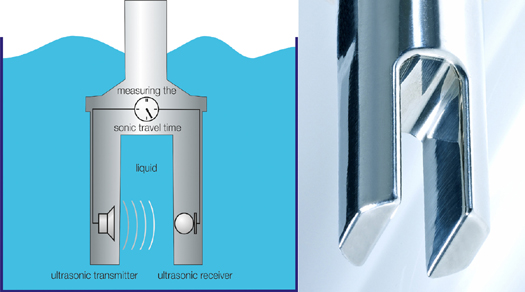The sonic velocity can easily be calculated by measuring the travel time of the sonic signal. With the sonic velocity the device calculates the concentration or density of the liquid. More concentration units can be displayed, e.g. Brix, solid content, dry matter or suspension density.
The measuring principle only requires a time measurement that can be realized digitally with outstanding accuracy and long time stability. Sonic velocity analyzers have no moving parts; therefore there is no long time degradation of their mechanical properties. Using this sensor technology, the user will have several advantages against competitive methods.
The sensor firmware calculates the sonic velocity by using the known distance between the transmitter and receiver. The typical sensor design includes transmitter and receiver within one rough construction.
The measuring method is independent of conductivity, color and transparency of the liquid and has excellent reliability. The user achieves an accuracy between 0.05 % and 0.1 % by weight. In addition to the sonic velocity measurement, all LiquiSonic® sensors have an integrated temperature measurement.
- concentration and density measurement
- phase interface detection
- multi-component analysis, e.g. in gas scrubbers and neutralizations
- monitoring of polymerization
- crystallization processes
Comparison of ultrasonic concentration measurement to other measuring methods
